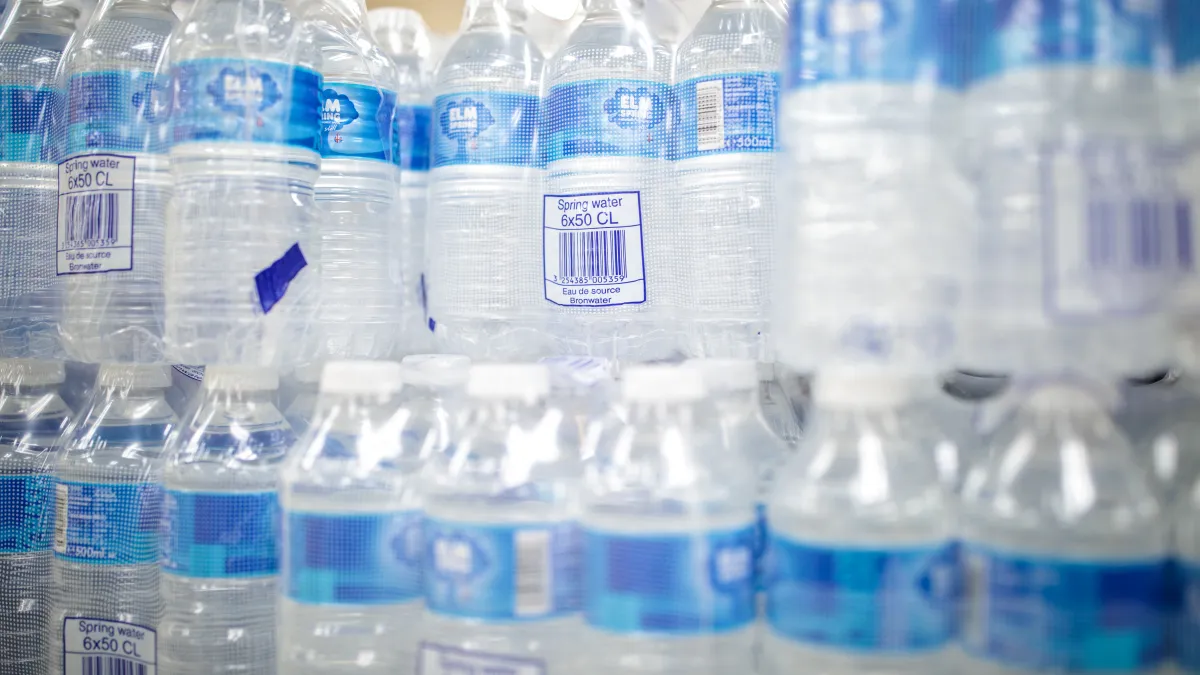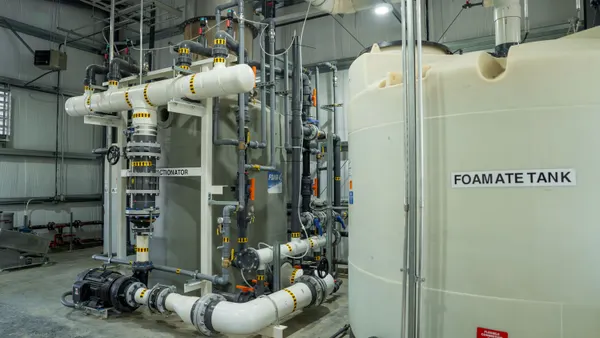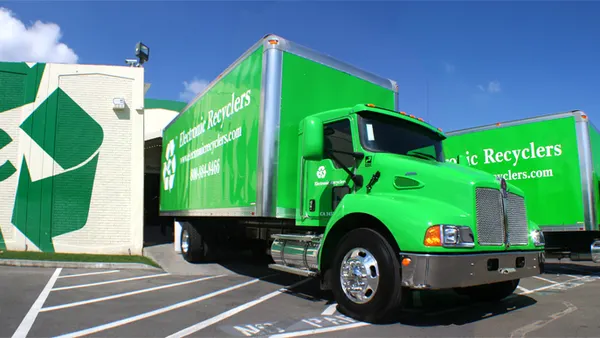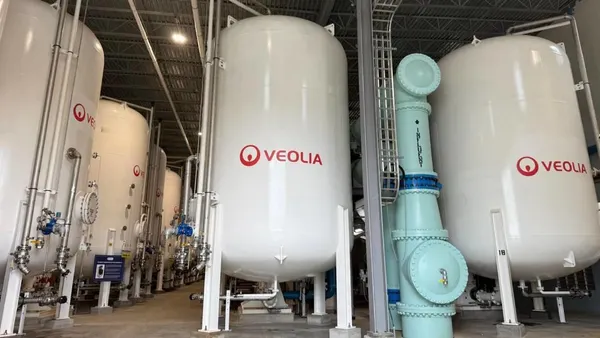UPDATE: May 18, 2021: Gov. Jay Inslee signed SB 5022 into law on Monday, with support from a range of industry trade groups and environmental organizations. Washington will become the second state with recycled content requirements for plastic beverage containers, the sixth to ban some form of expanded polystyrene (EPS) products and the first to set comprehensive opt-in requirements for single-use foodware.
Dive Brief:
- April 19: A bill in Washington designed to increase recycled content in packaging and ban some types of EPS containers is headed to Gov. Jay Inslee’s desk for signature.
- The bill, SB 5022, sponsored by Senator Mona Das, would require more recycled content in plastic beverage containers, trash bags and containers for household and personal care products. It bans EPS food service products such as clamshell containers, plates and cups, as well as EPS recreational coolers and packing peanuts. The bill also calls for plastic utensils, straws, and cup lids to only be provided to customers on request.
- Das’ bill follows several other state and national bills that see required minimum recycled content requirements as a tool to make packaging more sustainable and improve markets for recycled material. The bill has changed significantly since it was introduced in January as an extended producer responsibility (EPR) bill, which failed to gain support due to criticism that it gave too much control to packaging producers.
Dive Insight:
Industry experts and environmental groups say they expect SB 5022 to pass, in part, because of strong support for its minimum recycled content requirements, a concept that has been gaining traction nationally.
Steve Alexander, president and CEO of the Association of Plastic Recyclers, anticipates Das’ bill to be one of many such bills across the country in coming years. “I definitely see major changes coming, with more attention by brands to using recycled material and designing packaging to be compatible with recycling,” he said.
If SB 5022 passes, beverage manufacturers would be required to include more post-consumer recycled plastic in products over time, starting with 15% recycled content by weight by 2023 and ramping up to 50% by 2031. This would apply to most beverages in containers that hold between two ounces and a gallon, except for dairy milk and plastic 187 ml wine containers, which must reach 50% recycled content by 2036. It would exempt items like infant formula and medical products. Manufacturers of plastic trash bags would have to meet a 10% recycled content benchmark by 2023 and eventually use 20% by 2027. Household and personal care products would have to have 15% minimum recycled content by 2025 and 50% by 2031.
The bill has drawn support from local environmental groups, which rallied behind a similar bill in 2020. Gov. Inslee vetoed that bill last year, citing concerns over cost and timing of enacting new recycled content standards during the COVID-19 pandemic.
Other supporters include haulers such as the Washington Refuse and Recycling Association (WRRA) and Waste Management. “We believe the recycled content provisions help strengthen markets for recycling plastics,” said John Chelminiak, senior manager of public sector solutions for Waste Management.
Several participants at the recent Plastics Recycling Conference said state minimum-content standards can help drive specific local markets for particular recycled materials and can help achieve higher recycling rates when paired with other recycling methods, like extended producer responsibility programs.
One such bill moving through the New York state legislature would establish an EPR program for packaging and would require producers to meet certain state minimum post-consumer recycled content rates for their products.
Last year, California passed the country’s first minimum recycled content law for plastic beverage containers, starting with a minimum of 15% by 2022. This year, lawmakers in the state have introduced another bill, AB 478, which would set minimum recycled content requirements for plastic thermoform food containers starting at 10% and eventually reaching 30%.
Other speakers at the conference said they view federal minimum content standards as easier to administer and easier for companies to comply with than rolling out similar laws from state to state. The Break Free From Plastic Pollution Act, for example, calls for 65% reused or recycled content minimums for many types of packaging by 2027 and 75% recycling rates for beverage containers and paper by the same time. The CLEAN Future Act, meant to achieve net zero greenhouse gas emissions by 2050 through numerous measures, also includes measures to establish post-consumer recycled content standards for certain products.
Das’ bill also bans the sale and distribution of EPS packing peanuts beginning in June 2023. Sale of most portable EPS coolers and food service containers would be prohibited beginning in June 2024, but the ban does not apply to items like foam meat trays. Das introduced a similar EPS ban bill in 2020, which passed the Senate but didn’t make it out of the House.
Stakeholders like Waste Management say they don’t take a position on product bans, but Alexander said APR typically opposes bills that would ban specific plastic resins like EPS, favoring efforts to boost recycling infrastructure instead. “Bans are easy, but do they solve the problem?” he asked. “We are always going to have plastic packaging, and we have to deal with it. So we have to make sure recycling is a sustainable solution.”
Other states have recently enacted EPS packaging bans, most recently Virginia, which in March signed into law a ban on EPS packaging for food service items like clamshell takeout containers.
The Washington bill would also require that food service businesses provide plastic utensils, straws, condiment packaging and cup lids only upon request starting in 2022. Some items, like hot beverage lids and items provided through a drive-through window or delivery service wouldn’t be part of the law.
Das’ bill has undergone major changes since it debuted in January. The original version proposed an extended producer responsibility model as a framework for achieving minimum content goals and reaching a higher recycling rate. That version of the bill called for producers to fund and operate the EPR program, drawing opposition from the WRRA and others who thought it would leave waste haulers out of the picture. “It gave the people who created the problem all the control,” said Brad Lovaas, WRRA’s director.
The association initially put its support behind a competing bill that focused solely on setting recycled content standards for plastic packaging, but it now supports the final version of Das’ bill because it centers around recycled content and helps supports packaging that MRFs sometimes have trouble finding markets for, he said.
Correction: A previous version of this article incorrectly stated the year by which most items would need to contain 50% post-consumer recycled content.











